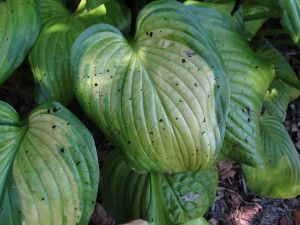Finding slug resistance among hosta varieties is relative. By late summer, you will find some holes in leaves in almost every variety, some a lot worst than others. There are ways to reduce slug injury in your host plantings.
Weather is a key factor. Wet summers means higher slug and snail populations. Dry summers is the opposite. They hide and multiply in a moist environment containing plenty of dead or decaying leaf and twig debris on the ground.
Good garden sanitation is important in reducing slug damage. Keep hosta beds free of weeds, fallen leaves and other wastes. Mulches and decaying foliage make an ideal slug haven. Cut your hostas back to ground level when foliage dies back late in autumn. Compost plant wastes away from hosta plantings..
During extended dry periods, irrigate hostas deeply but not frequently. Excess watering causes attracts snails and slugs. If you’re not watering sufficiently, plant leaf edges and tips will turn brown.
Hand-pick slugs from your hostas and nearby plants. Slugs are nocturnal feeders. Deposit them in a “kill jar” containing isopropyl alcohol or soapy water.
Make your own slug trap. Set shallow containers such as empty margarine and cream cheese containers are perfect. Filled containers with beer at dusk. Sorry, but fresh beer does attract more slugs than stale beer. Space traps 4-6 feet apart around hostas and other susceptible plants. Slugs will crawl into the bowls overnight and drown.
Hosta varieties with heavier and textured leaves are generally more slug resistant. Some examples include:
‘Abiqua Drinking Gourd’
‘Big Daddy’
‘Blue Mammoth’
‘Blue Plate Special’
‘Blue Shadows’
‘Blue Umbrellas’
‘Bright Lights’
‘Camelot’
‘Frances Williams’
‘Halcyon’
‘Krossa Regal’
‘June’
‘Love Pat’
‘Regal Splendor’
‘Sagae’
‘Spilt Milk’
‘Sum and Substance’
‘Tokudama’
The bottom line: Plant hosta varieties with thick or heavily textured leaves. Be ready to use slug bait or create your own bait trap. Slug baits are readily available from garden centers. Non-chemical alternatives are also effective. Most bait products contain metaldehyde. It is highly toxic by inhalation, moderately toxic by ingestion and may cause skin and eye irritation. It is poisonous on birds and other wildlife, including household pets.


 Posted in
Posted in 
